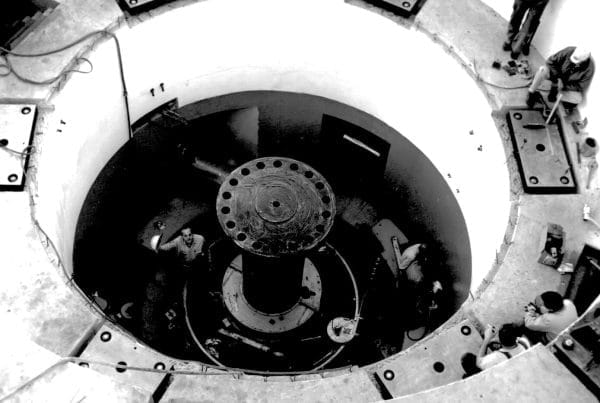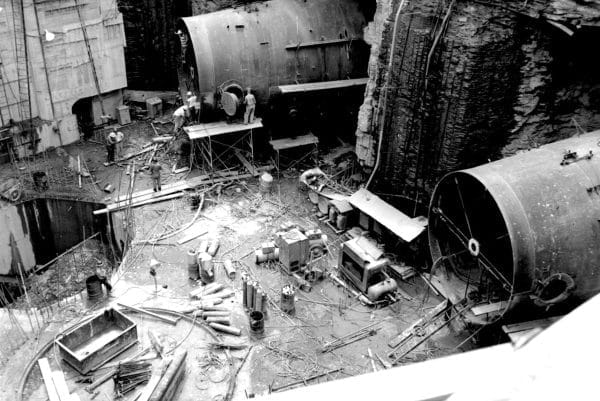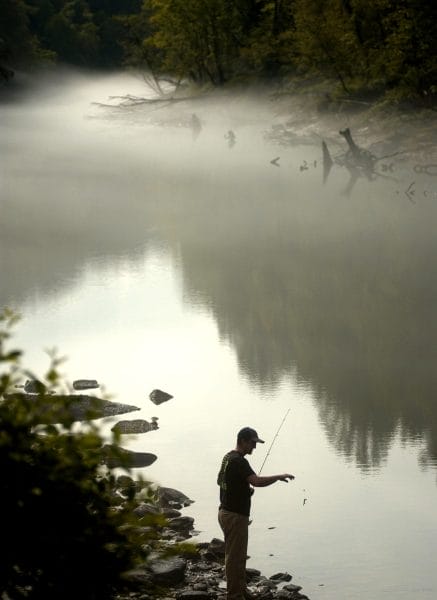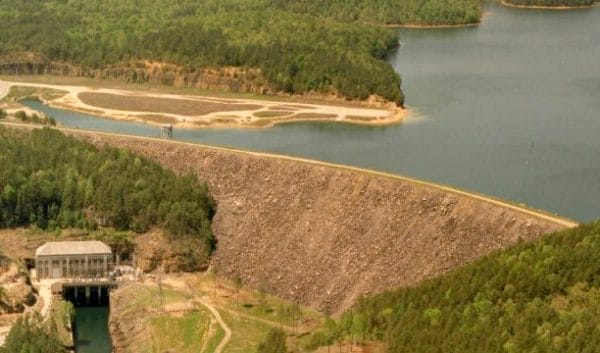Lewis Smith Dam and Lake
Lewis Smith Lake was created in 1961 by the Alabama Power Company as a result of the company’s construction of Lewis Smith Dam to produce hydroelectric power and improve river traffic conditions on the Sipsey fork of the Black Warrior River and provide recreational opportunities. The 21,200-acre lake straddles portions of Cullman, Walker, and Winston Counties in north-central Alabama.
 Lewis Smith Lake
The Black Warrior River had long been an important waterway for commerce and transportation in west Alabama. For most of the nineteenth century, however, erratic water levels and rocky shoals prevented most commercial river traffic above Tuscaloosa. With abundant coal deposits readily available along the upper Warrior River and frequent coal shortages along the lower Mississippi and in the Gulf states, mine and mill owners in Birmingham and west-central Alabama pressured the federal government to build a series of locks and dams north of Tuscaloosa in the late nineteenth and early twentieth century to transport the coal to where it was needed.
Lewis Smith Lake
The Black Warrior River had long been an important waterway for commerce and transportation in west Alabama. For most of the nineteenth century, however, erratic water levels and rocky shoals prevented most commercial river traffic above Tuscaloosa. With abundant coal deposits readily available along the upper Warrior River and frequent coal shortages along the lower Mississippi and in the Gulf states, mine and mill owners in Birmingham and west-central Alabama pressured the federal government to build a series of locks and dams north of Tuscaloosa in the late nineteenth and early twentieth century to transport the coal to where it was needed.
Still, even after the government locks and dams were operating, lack of water during dry periods restricted barge traffic. By the middle of the twentieth century, Alabama Power and the federal government were discussing the potential benefits of building a dam and creating a lake on the upper reaches of the Black Warrior to provide a new source for electricity, a new recreational asset for Alabamians, and better navigation downstream. A dam on the Sipsey Fork also would provide an additional source of drinking and industrial water for homes and businesses in Birmingham.
 Smith Dam Turbine
Alabama Power filed an application with the Federal Power Commission on July 27, 1954, for permission to construct hydroelectric projects on the Warrior River, including a proposed dam and powerhouse at the Sipsey Fork tributary, about 15 miles east of Jasper, just north of Parker Bridge at a site known as Upper New Hope. The projected flood zone was sparsely populated, although Clear Creek Falls—actually a pair of falls about a quarter mile apart in southeast Winston County—was a popular recreation spot for generations. In 1853, a post office was established near the falls and a small village, later known as Falls City, developed. But well before the dam’s construction the town dwindled, a victim mainly of its remote location. In 1953, the U.S. Postal Service abolished the Falls City post office altogether. It is unclear from historical records just how many families were displaced by the dam project. In addition to buying out residents, the company also paid to have 78 graves relocated from four cemeteries that were in the dam’s flood zone.
Smith Dam Turbine
Alabama Power filed an application with the Federal Power Commission on July 27, 1954, for permission to construct hydroelectric projects on the Warrior River, including a proposed dam and powerhouse at the Sipsey Fork tributary, about 15 miles east of Jasper, just north of Parker Bridge at a site known as Upper New Hope. The projected flood zone was sparsely populated, although Clear Creek Falls—actually a pair of falls about a quarter mile apart in southeast Winston County—was a popular recreation spot for generations. In 1853, a post office was established near the falls and a small village, later known as Falls City, developed. But well before the dam’s construction the town dwindled, a victim mainly of its remote location. In 1953, the U.S. Postal Service abolished the Falls City post office altogether. It is unclear from historical records just how many families were displaced by the dam project. In addition to buying out residents, the company also paid to have 78 graves relocated from four cemeteries that were in the dam’s flood zone.
Construction of Smith Dam began on Nov. 25, 1957. The $29 million project was formally dedicated on May 23, 1961, and named for Alabama Power Company president Lewis M. Smith, who had been closely involved in its planning and design. The earth- and rock-filled dam is 2,200 feet long and 300 feet tall, one of the largest dams of its type in the eastern United States. The dam’s base is a quarter-mile wide. A high-water emergency spillway was built on the west bank to accommodate heavy floods that were predicted to occur once every 50 years, but to date, water in the lake has never risen high enough to flow into the spillway.
 Smith Dam Powerhouse
The Smith Dam powerhouse contains two electric generators, rated at 78,750 kilowatts each. Water reaches the powerhouse, located just south of the dam, through two tunnels that are 26 feet in diameter and 1,925 feet long. The average annual electrical output from the generators is 233,000 megawatt-hours, but generation can vary depending on the availability of water. Smith Dam does not generate electricity constantly, being put into service when peak demand for electricity requires it or when market prices for electricity are favorable. In general, hydropower is the most economical way for Alabama Power to generate electricity, as there is no cost for fuel, but it cannot be used at all times because of limited supply. During the drought years in the early twenty-first century, for example, hydro-generation across Alabama Power’s system of dams, including Lewis Smith Dam, was reduced significantly.
Smith Dam Powerhouse
The Smith Dam powerhouse contains two electric generators, rated at 78,750 kilowatts each. Water reaches the powerhouse, located just south of the dam, through two tunnels that are 26 feet in diameter and 1,925 feet long. The average annual electrical output from the generators is 233,000 megawatt-hours, but generation can vary depending on the availability of water. Smith Dam does not generate electricity constantly, being put into service when peak demand for electricity requires it or when market prices for electricity are favorable. In general, hydropower is the most economical way for Alabama Power to generate electricity, as there is no cost for fuel, but it cannot be used at all times because of limited supply. During the drought years in the early twenty-first century, for example, hydro-generation across Alabama Power’s system of dams, including Lewis Smith Dam, was reduced significantly.
 Fishing on Lewis Smith Lake
Lewis Smith Lake is 35 miles long and has 500 miles of shoreline. The maximum depth at the dam is 264 feet. For many years, the land bordering Lewis Smith Lake remained relatively undeveloped. But since the 1980s, residential and commercial development resulting from the lake’s beauty and its recreational attractions has increased dramatically. The reservoir’s location near the cities of Birmingham and Huntsville makes the lake popular among second-home buyers. The lake is well-known for its deep, clear water and for its good sport fishing. In recent years, it has served as the site of several major professional bass fishing tournaments. Largemouth, striped, white, and spotted bass; black and white crappie; bluegill, longear, and redear sunfish; and flathead and channel catfish may be found in the lake. Public use areas, including boat launch facilities, are located at numerous sites around the reservoir. The lake and surrounding lands, including the adjoining William Bankhead National Forest and Sipsey Wilderness Area, also provide habitat for an abundance of other wildlife and threatened or endangered species, including the bald eagle.
Fishing on Lewis Smith Lake
Lewis Smith Lake is 35 miles long and has 500 miles of shoreline. The maximum depth at the dam is 264 feet. For many years, the land bordering Lewis Smith Lake remained relatively undeveloped. But since the 1980s, residential and commercial development resulting from the lake’s beauty and its recreational attractions has increased dramatically. The reservoir’s location near the cities of Birmingham and Huntsville makes the lake popular among second-home buyers. The lake is well-known for its deep, clear water and for its good sport fishing. In recent years, it has served as the site of several major professional bass fishing tournaments. Largemouth, striped, white, and spotted bass; black and white crappie; bluegill, longear, and redear sunfish; and flathead and channel catfish may be found in the lake. Public use areas, including boat launch facilities, are located at numerous sites around the reservoir. The lake and surrounding lands, including the adjoining William Bankhead National Forest and Sipsey Wilderness Area, also provide habitat for an abundance of other wildlife and threatened or endangered species, including the bald eagle.
 Lewis Smith Dam
The construction of Lewis Smith Dam and the resulting boost in the supply of reserve water on the upper Black Warrior River also made it feasible for Alabama Power to construct powerhouses downstream from the dam at the upgraded Holt Lock and Dam and Bankhead Lock and Dam in Tuscaloosa County. The Holt Lock and Dam and Bankhead Lock and Dam are owned by the U.S. Army Corps of Engineers. The company began generating electricity at Bankhead on July 12, 1963, and at Holt on August 15, 1968. The generating capacity for Bankhead is 53,985 kilowatts and for Holt it is 49,000 kilowatts. The dams are owned by the Corps of Engineers but the powerhouses are operated by Alabama Power and the power generated for Alabama Power customers.
Lewis Smith Dam
The construction of Lewis Smith Dam and the resulting boost in the supply of reserve water on the upper Black Warrior River also made it feasible for Alabama Power to construct powerhouses downstream from the dam at the upgraded Holt Lock and Dam and Bankhead Lock and Dam in Tuscaloosa County. The Holt Lock and Dam and Bankhead Lock and Dam are owned by the U.S. Army Corps of Engineers. The company began generating electricity at Bankhead on July 12, 1963, and at Holt on August 15, 1968. The generating capacity for Bankhead is 53,985 kilowatts and for Holt it is 49,000 kilowatts. The dams are owned by the Corps of Engineers but the powerhouses are operated by Alabama Power and the power generated for Alabama Power customers.
Further Reading
- Atkins, Leah Rawls. Developed for the Service of Alabama: The Centennial History of The Alabama Power Company, 1906-2006. Birmingham: Alabama Power Company, 2006.
- Willis, Kenneth D. “The Harnessing of the Black Warrior River.” Alabama Heritage 33 (Summer 1994): 19-25.



